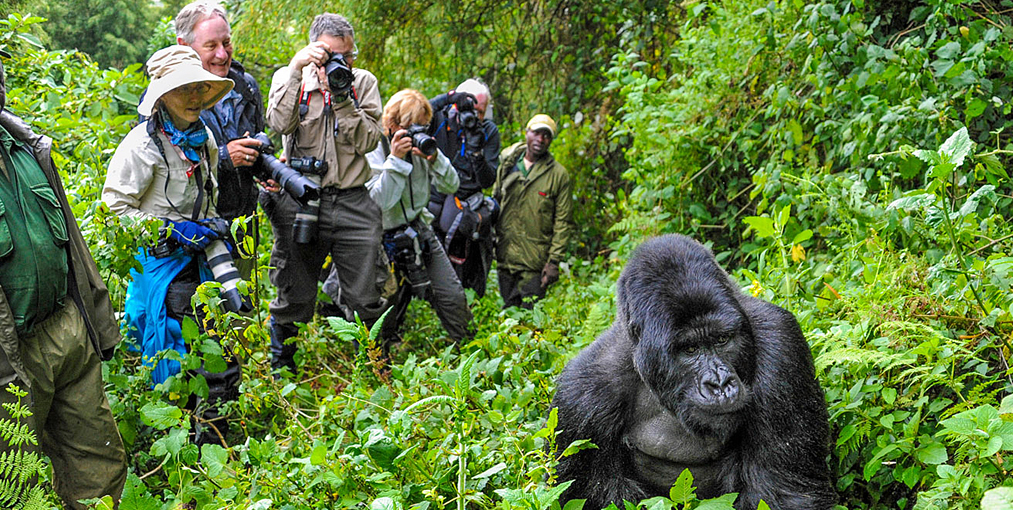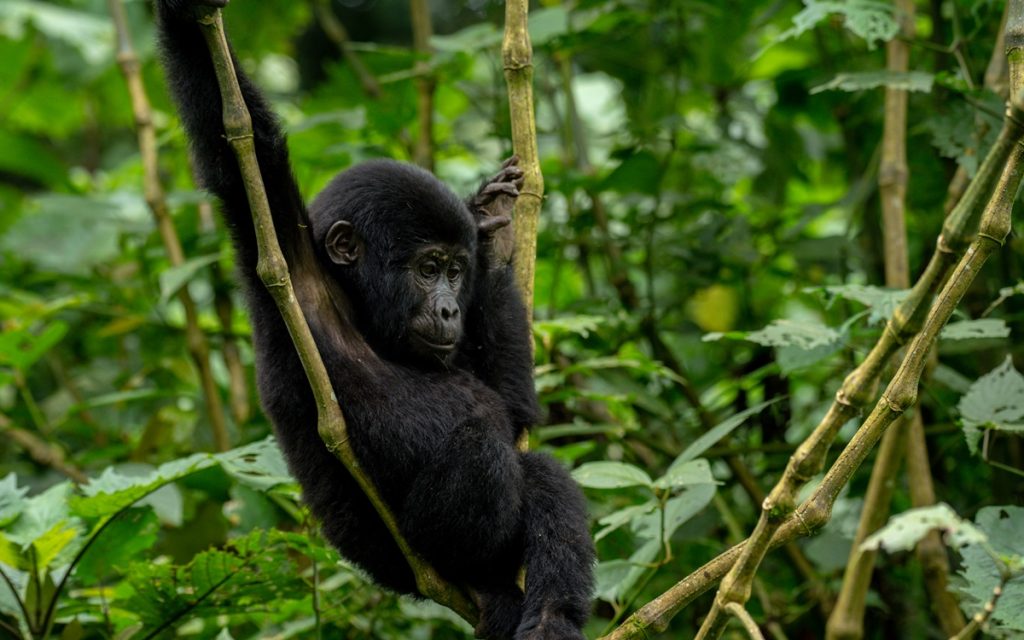- Written by: Anthony
- June 24, 2025
Africa’s Top 5 Big Cats: Where to See Them and How to Spot Them
Africa’s Top 5 Big Cats: The Ghosts, the Kings, and the Killers You Never See Coming
Africa doesn’t whisper when it wants to impress you. It shows you claws. Muscle. Eyes that stare through you like glass.
Some of them roar. Some are quiet, swift and will just vanish. When you meet one of Africa’s Big Cats, it doesn’t feel like a sighting—it feels like a warning.
This is their land. You’re just visiting to meet them.
Here you go, meet the Africa’s Top 5 Big Cats.

Male lion in Queen Elizabeth National Park
Lion – The Muscle
Lions are the rulers of the savanna, as many refer to them as King of the jungles!
You’ll find them stretched across the dirt like royalty in a heatwave. But make no mistake—these aren’t lazy animals. Lions are known for being lazy and calculative predators that hunt in groups. However strong and dangerous a buffalo is, they will take him down and roar loud enough before rattling the ribs.
- Where to spot them: Serengeti, Maasai Mara, Kruger, Hwange and other national parks.
- When they’re active: Mostly at night and early morning
- What they do best: Group hunts and scaring everything else into submission.
Suggested Safari Itineraries
6-Days Murchison Falls & Queen Elizabeth Safari with Big 5 Sightseeing
$ 1350
per person
Leopard (one of African Big 5 games)
Leopard – The Ghost
To see a leopard in the wild you need to wait, heart steady, and keep scanning your eyes on the tree tops. In the savanna hums softly around you, golden light bleeding into the horizon. Then, just as doubt begins to settle in, a whisper of movement—a tail curling like smoke above a branch, or a pair of golden eyes catching the dying light—freezes you in place.
There she is.
Silent. Alone. A shadow woven into bark and leaves. These cats don’t seek the spotlight. They live above it, suspended in trees like spirits of the forest, their muscles coiled with untold power. You feel it in your chest when she moves—the quiet confidence of a predator that does not need to prove anything.
She descends in silence, strikes with precision, and vanishes again, an impala slung over her shoulders like a fallen crown. She doesn’t stay to boast. She climbs, dragging her kill into the sanctuary of branches.
You don’t just see a leopard—you feel it. One moment, the bush is still. The next, a pair of golden eyes glint through the branches. A shape melts out of shadow, silent as a ghost. It doesn’t linger. It stares right through you, then vanishes—leaving your heart racing and your breath caught somewhere mid-thought. You’ll carry that glance for years.
- Where to spot them: South Luangwa, Sabi Sands, Serengeti, Okavango, Masai Mara.
- When they’re active: Dawn, dusk, and during night drives
- What they do best: Ambush kills and total invisibility

The Cheetah : Part of African Big cats
Cheetah – The Rocket
Unlike leopards and other big cats, they have semi-retractable claws. No brute strength. Just speed.
Cheetahs aren’t about brawling—they’re about bursting. When they run, it’s like watching a fur-covered missile. Their slim build and black tear lines give them a different kind of power: elegance at 112 km/h.
- Where to see them: Maasai Mara, Serengeti, Kgalagadi, Ngorongoro, Kidepo Valley, Central Namibia
- When they’re active: Daytime hunters—rare among cats
- What they do best: High-speed chases with pinpoint kills

Caracal – The Acrobat
You might not expect a cat this small to make the list, but caracals are pure wild. They’re known for their piercing eyes, powerful back legs, and ear tufts that stick straight up like antennas.
And their signature move? Snatching birds out of the sky mid-flight.
- Where to see them: Mountain Zebra Park, Karoo, Botswana.
- When they’re active: Nighttime, mostly seen on spotlight safaris
- What they do best: Precision pouncing and vertical leaps

African Big cats : The Serval cats
Serval – The Sniper
Think of the serval as the sniper of Africa. Long legs. Small head. Giant ears. And a hunting style that’s all about listening, leaping, and killing in a single bounce.
They’re more cat than cat. And when they walk through tall grass, they disappear. Where to see them: Ngorongoro, Amboseli, Okavango Delta.
When they’re active: Mostly at night and early morning. What they do best: Catching rats, birds, and frogs with sniper-like precision.
Other Big Cats
There are other incredible giant big cats such as tigers and jaguars though not found in Africa. Native to America, The jaguar (Panthera onca) is a big cat best known for its spotted coat and hunting prowess.
10 Tips to Spot Big Cats on Safari
Go During the Dry Season – Less vegetation, more visibility. Animals gather near water sources.
- Book Early Morning and Sunset Drives – Big cats move when it’s cool. You won’t find them sunbathing at noon.
- Use a Guide Who Knows the Territory – Local guides track claw marks, scat, and warning calls. Don’t wing it.
- Watch the Prey, Not the Predator – If impalas freeze and stare, they’re not admiring the sunset—a cat’s nearby.
- Stay Silent – Loud voices and rustling gear kill your chances. Be still. Be quiet.
- Bring Binoculars – Not everything happens near the road. Cheetahs perch on termite mounds. Leopards rest in trees.
- Scan Trees and Shadows – Especially for leopards and servals. Look up, not just around.
- Look for Vultures – Circling birds often mean a fresh kill… and where there’s a kill, there’s a cat.
- Return to the Same Spot Later – Cats revisit their territories. A failed sighting at sunrise could be jackpot by dusk.
- Do a Night Drive – Especially in Zambia and Botswana. You’ll catch leopards, servals, and caracals in their element.
Recommended Safaris
8 Days River Nile, Murchison Falls & Kidepo Wilderness Safari
$ 2400
per person3 Days Murchison Falls & White rhino Tracking in Ziwa
$ 620
per personAfrican Big Cat FAQs
- Which is the most dangerous big cat in Africa?
Step too close to a pride and you’ll understand. Lions don’t warn—they charge, unified and ruthless. There’s a reason they’re called kings. But if danger had a shadow, it would wear spots. Leopards don’t roar. They vanish. Then strike from nowhere. You’ll never hear the warning until it’s far too late.
- Are cheetahs endangered?
They run like the wind, but even the fastest can’t outrun fences. Each year, their grasslands shrink, carved up by roads, farms, and people. Once, they sprinted across thousands. Now, fewer than 7,000 remain, clinging to the last open spaces. Their silence says what stats can’t. They’re still here—but barely.
- Can I see all five cats in one trip?
Rare—but possible in Kenya, Tanzania, or South Africa, if you visit varied habitats and work with sharp guides.
- What’s the smallest African big cat?
The serval, followed closely by the caracal. Don’t let the size fool you—they’re wild, effective predators.
- Do caracals and servals live near people?
Yes, especially near farmlands and villages where small prey is abundant. But they’re extremely shy and mostly nocturnal.
Final Thoughts: Africa’s Big Cats Don’t Perform—They Appear
You can’t schedule them and definitely you can’t bribe them.
When nature decides, you will vividly see them. All you can do is show up, shut up, and hope the wild decides you’re worth a look.
The lions will give you power. The leopards will show you silence. The cheetahs will show you speed. And the caracals and servals? They’ll give you bragging rights for life.
So—are you ready to meet the cats that don’t meow, don’t play, and don’t care who you are?
Anthony

Ready for your ultimate wildlife experience?
Chat with us, our team is always here to help!
You may also like …

Got any questions
about traveling to Uganda?
Get in touch.








